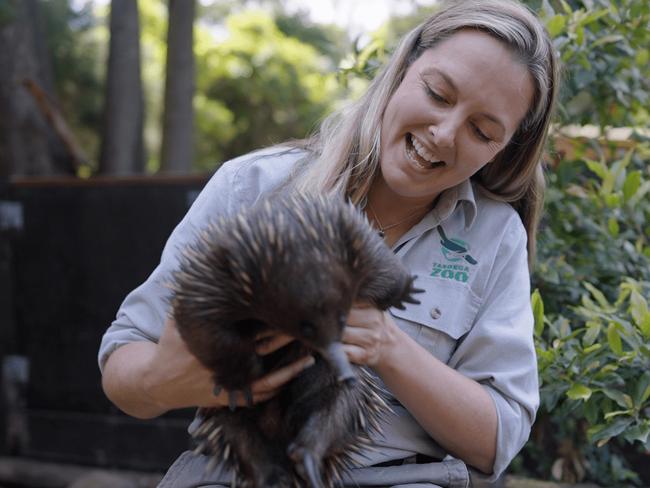Future You Initiative to show girls they’ve got the smarts for STEM
Four in 10 girls don’t think they’re smart enough to do STEM – and Dr Phoebe Meagher was once one of them. The conservationist is one of the faces of a new campaign to tackle the gender divide.
Education
Don't miss out on the headlines from Education. Followed categories will be added to My News.
Too many girls — four in 10 — don’t think they’re smart enough to do science, technology, engineering or maths (STEM). Dr Phoebe Meagher was once one of them.
The “alarming” finding from Australia’s 2021 Youth in STEM survey is one reason the Taronga Zoo conservationist is happy to be one of the faces of an Australian government initiative tackling the gender divide in STEM career paths.
The Future You online hub, launched nationally this week, is designed to inspire primary school students to explore the diversity of careers in the area.
“You can’t be what you can’t see,” Dr Meagher said. “We want children to be able to see more role models in the areas of science, technology, engineering and maths — to see more people saving animals or coming up with cures for disease.
“Future You is about getting all these diverse careers on screen so kids can be what they can see.”

The most recent Census revealed there’s still a massive skills gap in areas like IT and a persistent gender gap, with just one in five information and communications technology professionals and managers identifying as female.
This year, the number of HSC students taking physics — 7730 — has tumbled to its lowest in 20 years, while the proportion of girls studying the subject has failed to budge in more than a decade.
The Youth in STEM survey showed 21 per cent of girls wanted a STEM career compared to 42 per cent of boys.
“It’s horrifying that 14 to 17-year-old girls don’t think they’re smart enough to study STEM, but I can really associate with that feeling as I was that 12-year-old girl who didn’t think she could have that career,” Dr Meagher said.
“But one teacher saw my passion for biology and encouraged me … and I’m reaping the rewards.
“Working in a place like Taronga where you can see the output of your work, where you can, for instance, work in breeding programs for critically endangered animals and reintroduce them into the wild.”

Professor Lisa Harvey-Smith, an astrophysicist, author and Women in STEM ambassador who is leading the Future You initiative, said it was vital to boost female participation.
“We know that when girls start high school at age 12 or 13, they are more confident than boys in STEM, yet by the age of 15 the reverse is true,” she said. “Girls’ confidence is plummeting within high school. We don’t know why.”
Professor Harvey-Smith wants to see systemic and attitudinal change about STEM.
“Studying STEM doesn’t mean you have to be a scientist in a lab coat, or an engineer building a bridge in hi-vis and a hard hat,” she said.
“I’m a physicist and it’s an amazing career where you can study things exploding 10 billion light years away.”
Future You resources are being rolled out online to primary schools nationwide.
DROP IN DEMAND FOR TOURISM COURSES
For dance and drama students Sophia Tsoltoudis and Zoe Napper, taking on the Entertainment Industry subject in this year’s HSC was a no-brainer.
Yet enrolments for the Vocational Education and Training (VET) course are down almost 20 per cent this year, as students shy away from subjects associated with industries that bore the brunt of the pandemic lockdowns and restrictions.
Fewer than 1000 students sat for the Entertainment Industry exam on Monday, and next week just over 150 will sit for Tourism, Travel and Events, with the latter VET subject experiencing a 44 per cent decrease in enrolments since 2021.
Even the popular VET courses of hospitality and retail have each seen a 6 per cent downturn in enrolments this year, with 6795 and 1503 enrolments respectively.
If the trend continues, industry insiders are concerned it will add to the skills shortage in these now re-emerging areas.

Tourism & Transport Forum CEO Margy Osmond said the drop in enrolments for courses focusing on the tourism, travel and entertainment industries was “deeply concerning”.
“There’s already a shortage of workers in industries like tourism. Across the country, we don’t have enough hotel managers, motel managers, tour guides, travel consultants or chefs to meet demand,” she said.
“These figures suggest fewer students are choosing to take up subjects in these areas, despite the job opportunities on offer.
“If enrolments don’t pick up in coming years, we could see the skills shortages worsen in sectors like tourism, which are still recovering after unprecedented struggles during the pandemic.”
Ms Osmond said the fee-free TAFE courses announced in this week’s federal budget were a welcome measure to help address the skills shortage in sectors like tourism, but said it wasn’t enough to solve the issue.
“We need more industry-led training, to give young people job-ready skills to secure work in industries which need them right now,” she said.
For Georges River College Oatley campus students Sophia and Zoe, the Entertainment Industry course gave them a comprehensive overview of the industry.
The pair met during an audition for a musical at the age of eight, and they’ve been best friends since.
“We have been interested in performance our whole lives — singing, dancing, acting,” Sophia said. “We wanted to get some insight into what goes on behind the scenes.”
The girls, 17, were confident they’d done well in this week’s exam and post-HSC — having already obtained a certificate III — they’re keen to get straight to work in the industry.
“Even if we end up on the stage we’ll have an appreciation for all the roles backstage and front of house — without whom the show would not go on,” Zoe said.
A NSW Educations Standards Authority (NESA) spokesperson said that course enrolments fluctuated each year, based on a number of factors.
“Students choose subjects for different reasons, including their interests, their future goals and which courses are most suited to their chosen pathway to university, employment or further training,” the spokesperson said.
“We know that students see practical value and benefit in vocational studies because year on year close to 30 per cent choose to study a (VET) subject.
“One of the strengths of the HSC is that students can leave school with a dual credential — the HSC as well as a VET qualification that is industry-endorsed and nationally recognised.”
Demand for VET courses is expected to increase as part of HSC reforms announced earlier in the year.
Currently only one VET course can be included as part of a student’s ATAR, but from 2025 more HSC courses, including VET, will be able to contribute to the rank.
In announcing the measures earlier this year, Minister for Skills and Training Alister Henskens said the move would stop barriers to a “pipeline of job-ready high school graduates”.
Got a news tip? Email weekendtele@news.com.au



